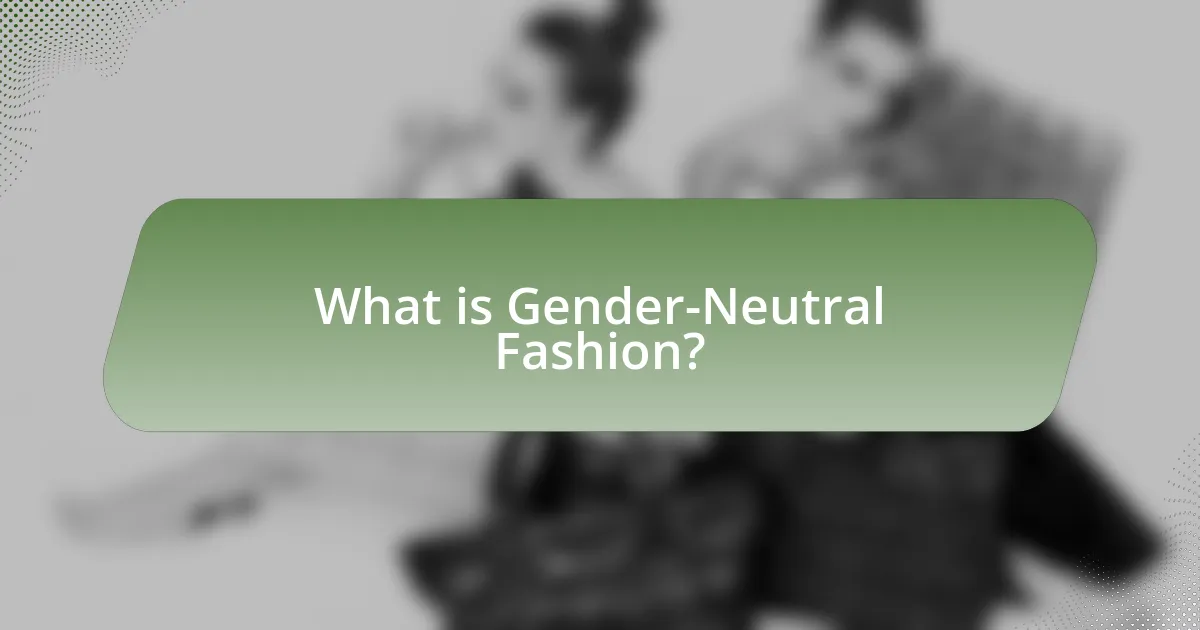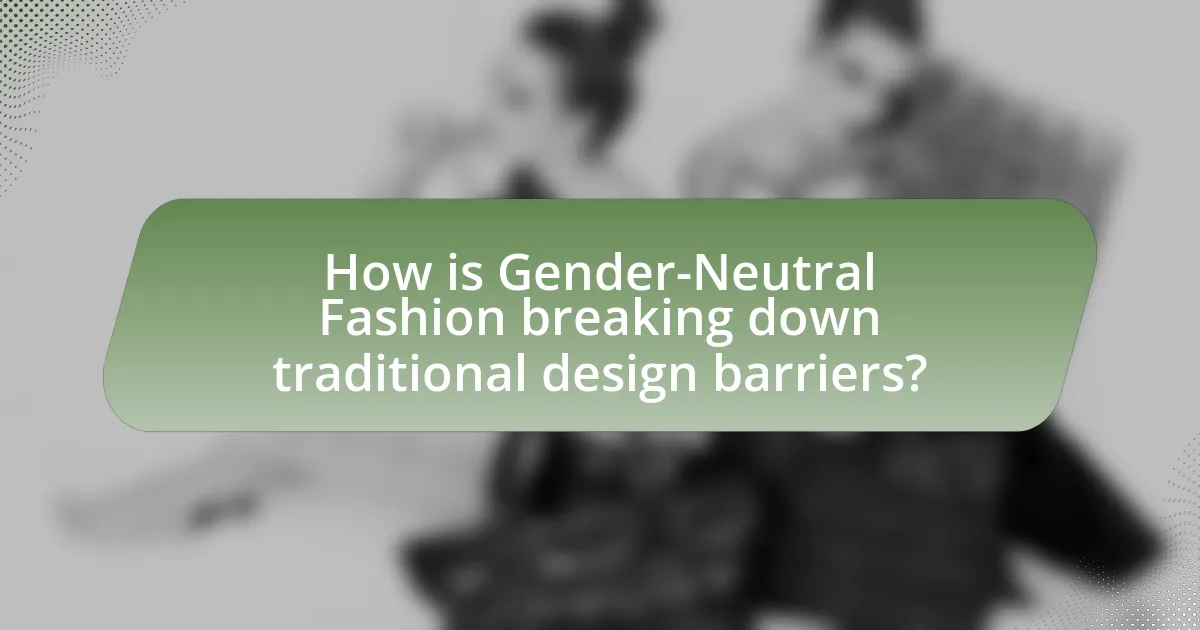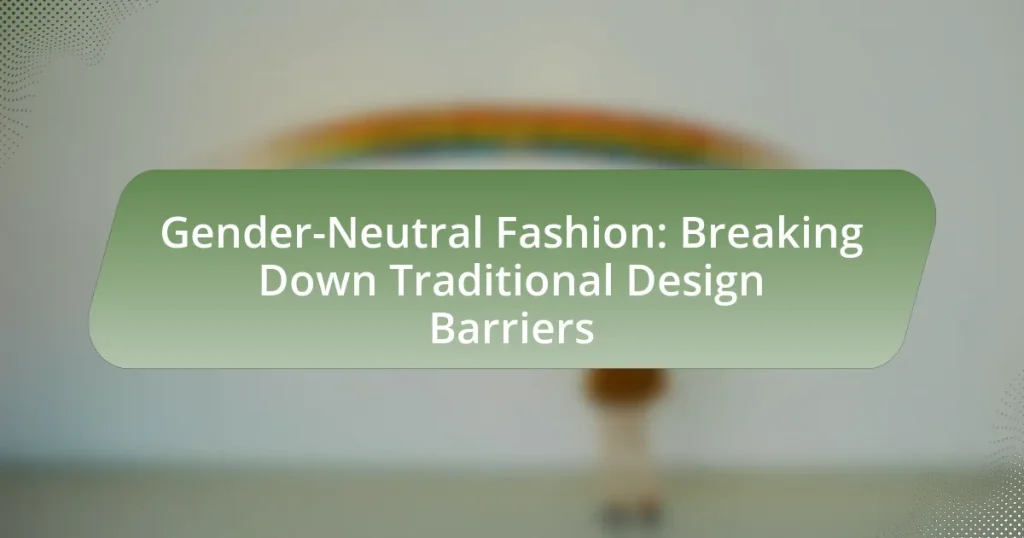Gender-neutral fashion is a clothing approach designed to be worn by individuals of any gender identity, promoting inclusivity and challenging traditional gender norms. This article explores the characteristics, importance, and historical influences of gender-neutral fashion, highlighting how it differs from conventional fashion by eliminating binary classifications. It discusses the role of cultural shifts and activism in advancing this movement, the design principles central to gender-neutral collections, and the challenges faced by designers. Additionally, the article examines future trends, the impact of technology, and practical tips for consumers to support and incorporate gender-neutral fashion into their wardrobes.

What is Gender-Neutral Fashion?
Gender-neutral fashion refers to clothing designed to be worn by individuals regardless of their gender identity, promoting inclusivity and breaking away from traditional gender norms in fashion. This approach often features unisex styles, silhouettes, and colors that do not conform to conventional male or female categories. The rise of gender-neutral fashion has been supported by cultural shifts towards acceptance of diverse gender identities, with brands like Telfar and Rad Hourani leading the way in creating collections that emphasize fluidity and self-expression.
How does Gender-Neutral Fashion differ from traditional fashion?
Gender-neutral fashion differs from traditional fashion by eliminating the binary classification of clothing based on gender, allowing for designs that can be worn by anyone regardless of their gender identity. Traditional fashion typically adheres to gender-specific styles, colors, and fits, reinforcing societal norms that dictate what is appropriate for men and women. In contrast, gender-neutral fashion focuses on inclusivity and versatility, often utilizing unisex silhouettes, neutral colors, and adaptable designs that cater to a broader audience. This shift reflects a growing cultural movement towards acceptance and fluidity in gender expression, supported by the rise of brands that prioritize gender inclusivity, such as Telfar and Rad Hourani, which have gained recognition for their commitment to breaking down these traditional barriers.
What are the key characteristics of Gender-Neutral Fashion?
Gender-neutral fashion is characterized by its inclusivity, versatility, and lack of gender-specific design elements. This fashion approach eliminates traditional gender norms by offering clothing that can be worn by anyone, regardless of their gender identity. Key characteristics include unisex silhouettes, neutral color palettes, and functional designs that prioritize comfort and practicality over gendered aesthetics. The rise of gender-neutral fashion reflects a broader societal shift towards acceptance and diversity, as evidenced by brands like Telfar and Rad Hourani, which have successfully integrated these principles into their collections.
Why is Gender-Neutral Fashion important in today’s society?
Gender-neutral fashion is important in today’s society because it promotes inclusivity and challenges traditional gender norms. This fashion movement allows individuals to express their identity without being confined to binary gender categories, fostering a sense of belonging for diverse gender identities. According to a 2021 report by McKinsey & Company, the global gender-neutral fashion market is projected to grow significantly, reflecting a shift in consumer preferences towards brands that embrace diversity and inclusivity. This trend not only supports individual expression but also encourages brands to innovate and rethink their design approaches, ultimately leading to a more equitable fashion industry.
What historical factors have influenced Gender-Neutral Fashion?
Historical factors influencing gender-neutral fashion include the feminist movement, the LGBTQ+ rights movement, and cultural shifts towards individualism and self-expression. The feminist movement of the 1960s and 1970s challenged traditional gender roles, promoting the idea that clothing should not be confined to binary definitions. The LGBTQ+ rights movement further pushed against gender norms, particularly in the 1980s and 1990s, advocating for visibility and acceptance of diverse gender identities. Additionally, cultural shifts in the late 20th and early 21st centuries, characterized by a growing emphasis on personal identity and self-expression, have led to a broader acceptance of clothing that transcends traditional gender boundaries. These movements collectively contributed to the emergence and popularity of gender-neutral fashion in contemporary society.
How have cultural shifts impacted the perception of gender in fashion?
Cultural shifts have significantly transformed the perception of gender in fashion by promoting inclusivity and challenging traditional gender norms. The rise of movements advocating for gender equality and LGBTQ+ rights has led to a broader acceptance of gender-neutral clothing, allowing individuals to express their identities beyond binary classifications. For instance, the increasing visibility of non-binary and gender-fluid individuals in media and fashion campaigns has encouraged brands to adopt more inclusive designs, as seen with companies like Gucci and Telfar, which feature collections that cater to all genders. This shift is supported by data indicating that 56% of Gen Z consumers prefer brands that offer gender-neutral options, reflecting a societal move towards dismantling rigid gender roles in fashion.
What role have activists played in promoting Gender-Neutral Fashion?
Activists have played a crucial role in promoting gender-neutral fashion by challenging traditional gender norms and advocating for inclusivity in clothing design. Through campaigns, social media, and public demonstrations, activists have raised awareness about the limitations of binary gendered clothing, pushing brands to adopt more inclusive practices. For instance, the rise of gender-neutral collections from major retailers, influenced by activist movements, reflects a significant shift in the fashion industry towards embracing diversity. This advocacy has led to increased visibility for non-binary and gender non-conforming individuals, fostering a broader acceptance of gender-neutral styles in mainstream fashion.

How is Gender-Neutral Fashion breaking down traditional design barriers?
Gender-neutral fashion is breaking down traditional design barriers by challenging the binary notions of gender in clothing, allowing for a more inclusive approach to style. This movement promotes designs that are not confined to male or female categories, enabling individuals to express their identity without the constraints of conventional gender norms. For instance, brands like Telfar and Rad Hourani have successfully created collections that appeal to a diverse audience, demonstrating that clothing can be versatile and accessible to all genders. The rise of gender-neutral fashion reflects a broader societal shift towards acceptance and fluidity in gender identity, as evidenced by increased consumer demand for unisex options, which has led to a significant impact on the fashion industry’s design practices and marketing strategies.
What design principles are central to Gender-Neutral Fashion?
Central design principles of Gender-Neutral Fashion include inclusivity, versatility, and minimalism. Inclusivity ensures that clothing is designed to fit a wide range of body types and gender identities, promoting a sense of belonging for all individuals. Versatility allows garments to be styled in multiple ways, catering to diverse personal expressions and preferences. Minimalism focuses on clean lines and neutral colors, which help eliminate traditional gender markers in clothing. These principles are supported by the growing demand for fashion that transcends binary gender norms, as evidenced by the increasing number of brands adopting gender-neutral collections.
How do these principles challenge conventional gender norms?
Gender-neutral fashion principles challenge conventional gender norms by promoting clothing that is not restricted by traditional gender classifications. This approach allows individuals to express their identity beyond the binary framework of male and female, thereby dismantling stereotypes associated with gendered clothing. For instance, brands like Telfar and Rad Hourani have successfully created collections that cater to all genders, demonstrating that fashion can be inclusive and diverse. This shift is supported by a growing societal acceptance of non-binary identities, as evidenced by surveys indicating that a significant percentage of younger generations identify as non-binary or gender non-conforming.
What materials and techniques are commonly used in Gender-Neutral designs?
Gender-neutral designs commonly utilize materials such as organic cotton, linen, and recycled polyester, along with techniques like unstructured tailoring and modular design. Organic cotton and linen are favored for their versatility and sustainability, appealing to a broad audience. Recycled polyester is increasingly used to promote eco-friendliness while maintaining durability. Unstructured tailoring allows for a relaxed fit that suits various body types, while modular design enables customization, enhancing the wearer’s personal expression. These materials and techniques collectively support the ethos of gender-neutral fashion by prioritizing comfort, sustainability, and inclusivity.
What are the challenges faced by designers in creating Gender-Neutral Fashion?
Designers face several challenges in creating gender-neutral fashion, primarily due to societal norms and expectations surrounding gender. These norms often dictate specific styles, colors, and fits that are traditionally associated with masculinity or femininity, making it difficult for designers to create pieces that appeal to all genders. Additionally, the fashion industry is heavily influenced by marketing strategies that target specific gender demographics, which can limit the acceptance and visibility of gender-neutral designs.
Moreover, there is a lack of established sizing standards that accommodate a broader range of body types, complicating the design process. According to a report by the Council of Fashion Designers of America, only 20% of brands offer gender-neutral options, highlighting the limited market support for such designs. This creates a risk for designers who may be hesitant to invest in gender-neutral collections without guaranteed consumer demand.
How do market perceptions affect the success of Gender-Neutral collections?
Market perceptions significantly influence the success of gender-neutral collections by shaping consumer acceptance and demand. Positive perceptions, driven by increasing societal acceptance of gender fluidity, can lead to higher sales and brand loyalty, as evidenced by a 2021 report from McKinsey, which found that 60% of consumers are more likely to purchase from brands that promote inclusivity. Conversely, negative perceptions can hinder market penetration, as brands may struggle to connect with traditional consumer bases that favor gender-specific products. Thus, the alignment of brand messaging with evolving societal norms is crucial for the commercial viability of gender-neutral collections.
What barriers exist within the fashion industry regarding inclusivity?
Barriers within the fashion industry regarding inclusivity include a lack of representation, limited sizing options, and entrenched gender norms. The industry often prioritizes traditional gendered designs, which marginalizes non-binary and gender-fluid individuals. According to a 2021 report by McKinsey & Company, only 1% of fashion brands offer gender-neutral clothing lines, highlighting the scarcity of options for diverse gender identities. Additionally, many brands fail to provide extended sizing, which excludes a significant portion of the population, as noted by the 2019 study from the University of North Texas, indicating that 67% of women in the U.S. wear sizes 14 and above, yet these sizes are often underrepresented in mainstream fashion. These factors collectively hinder the progress toward a more inclusive fashion landscape.

What are the future trends in Gender-Neutral Fashion?
Future trends in gender-neutral fashion include increased inclusivity, sustainable materials, and the rise of unisex collections. As societal norms evolve, brands are focusing on designs that cater to all genders, promoting a more inclusive approach to fashion. The use of sustainable materials is gaining traction, with consumers increasingly demanding eco-friendly options that align with their values. Additionally, major fashion houses are launching unisex collections, reflecting a shift towards breaking traditional gender barriers in design. This trend is supported by market research indicating a growing consumer preference for gender-neutral clothing, with a significant percentage of shoppers expressing interest in brands that offer such options.
How is technology influencing the evolution of Gender-Neutral Fashion?
Technology is significantly influencing the evolution of gender-neutral fashion by enabling innovative design processes and enhancing accessibility. Advanced technologies such as 3D printing and digital design software allow designers to create versatile clothing that transcends traditional gender norms, facilitating the production of unisex garments tailored to diverse body types. Additionally, e-commerce platforms and social media have democratized fashion, allowing brands that focus on gender-neutral styles to reach wider audiences and engage with consumers directly. This shift is supported by data indicating that the global gender-neutral fashion market is projected to grow, reflecting changing consumer preferences towards inclusivity and self-expression.
What innovations are being introduced to enhance inclusivity in fashion?
Innovations enhancing inclusivity in fashion include the development of gender-neutral clothing lines, adaptive fashion for individuals with disabilities, and the use of diverse models in marketing campaigns. Gender-neutral clothing lines, such as those launched by brands like Telfar and Rad Hourani, challenge traditional gender norms by offering styles that are not confined to male or female categories. Adaptive fashion, exemplified by brands like Tommy Hilfiger and Zappos, incorporates features like adjustable fits and easy closures to accommodate various physical needs. Additionally, the representation of diverse body types, ethnicities, and gender identities in advertising campaigns has increased, as seen in initiatives by companies like Aerie and Savage X Fenty, which promote body positivity and inclusivity. These innovations collectively aim to create a more inclusive fashion landscape that caters to a broader audience.
How can sustainability be integrated into Gender-Neutral Fashion?
Sustainability can be integrated into gender-neutral fashion by utilizing eco-friendly materials, promoting ethical production practices, and encouraging circular fashion principles. Eco-friendly materials, such as organic cotton, recycled polyester, and Tencel, reduce environmental impact and resource consumption. Ethical production practices, including fair labor conditions and local sourcing, ensure that the manufacturing process respects both people and the planet. Circular fashion principles, such as designing for longevity and facilitating garment recycling, minimize waste and promote a sustainable lifecycle for clothing. These strategies collectively contribute to a more sustainable approach to gender-neutral fashion, aligning with the growing consumer demand for responsible and inclusive fashion choices.
What can consumers do to support Gender-Neutral Fashion?
Consumers can support gender-neutral fashion by choosing to purchase from brands that prioritize inclusivity in their designs. By actively seeking out and buying clothing from companies that offer gender-neutral options, consumers help to drive demand for such products. Research indicates that the global gender-neutral fashion market is projected to grow significantly, reflecting a shift in consumer preferences towards more inclusive styles. Additionally, consumers can advocate for gender-neutral fashion by promoting these brands on social media, thereby increasing visibility and encouraging others to consider non-binary options in their wardrobe.
How can individuals make informed choices when purchasing clothing?
Individuals can make informed choices when purchasing clothing by researching brands, understanding fabric materials, and considering ethical production practices. Researching brands involves looking into their reputation, customer reviews, and transparency regarding sourcing and manufacturing processes. Understanding fabric materials helps consumers assess quality, comfort, and sustainability; for instance, organic cotton is often more environmentally friendly than conventional cotton. Considering ethical production practices, such as fair labor conditions and eco-friendly manufacturing, allows individuals to support brands that align with their values. According to a 2021 survey by McKinsey & Company, 67% of consumers consider sustainability when making fashion purchases, highlighting the importance of informed decision-making in clothing choices.
What are some brands that exemplify Gender-Neutral Fashion principles?
Some brands that exemplify Gender-Neutral Fashion principles include Telfar, Rad Hourani, and Gender Free World. Telfar is known for its unisex designs that prioritize inclusivity and accessibility, while Rad Hourani focuses on androgynous silhouettes that challenge traditional gender norms. Gender Free World offers a range of clothing that is explicitly designed to be worn by anyone, regardless of gender, promoting a more fluid approach to fashion. These brands collectively demonstrate a commitment to breaking down traditional design barriers by creating versatile and inclusive clothing options.
What are practical tips for incorporating Gender-Neutral Fashion into your wardrobe?
To incorporate gender-neutral fashion into your wardrobe, start by selecting versatile pieces that can be styled in multiple ways, such as oversized shirts, tailored trousers, and unisex outerwear. These items allow for a fluid expression of personal style regardless of gender norms. Additionally, focus on neutral colors and simple patterns, as they tend to be more adaptable and can easily mix and match with various outfits.
Investing in high-quality basics, like plain t-shirts and sweatshirts, can also enhance the foundation of a gender-neutral wardrobe. Accessories play a crucial role; consider opting for bags, hats, and shoes that are designed to be unisex, further promoting a non-binary aesthetic.
Lastly, explore brands that specialize in gender-neutral clothing, as they often provide innovative designs that challenge traditional gender boundaries. This approach not only supports inclusive fashion but also expands your wardrobe with unique pieces.




